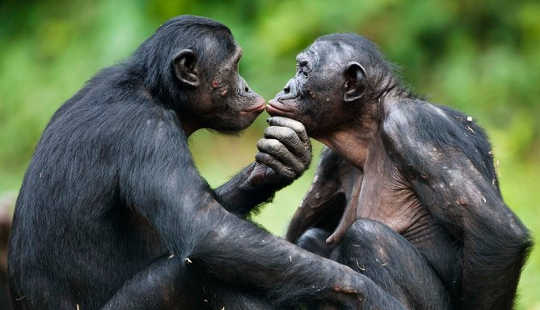
The reason why, in terms of evolution, organisms have sex may seem rather obvious – they do it to reproduce. Clearly, natural selection must favour individuals who can reproduce over those who can’t. But this is missing the point. For many species there is an alternative: asexual reproduction.
So why has sex evolved in so many species? Surprisingly, there’s no single clear answer to this question. Indeed, to date, researchers have developed more than 20 different hypotheses. Lately, a number of experiments have started testing these theories, taking us closer to finding a solution.
In asexual species, a female reproduces without the genetic contribution of a male and makes daughters effectively identical to herself. Anyone who’s had their roses blighted by plant lice (alias: greenflies or aphids) will know just how successful a strategy this can be.
Key to the intellectual problem is the fact that males often do no investing into the offspring. While sexual mothers need to produce both sons and daughters, an asexual female can make daughters alone. If females are the investing sex (they make eggs, feed the young etc), this makes it far easier to quickly grow the population: one asexual female can become two, two can become four, four can become eight etc. This has been confirmed by experiments comparing effectively asexual beetles with sexual beetles in the lab.
Apart from mammals (including humans) and birds, there are asexual species in just about every taxonomic group, including some fish, reptiles, plants and insects – but they are uncommon. So despite the advantages of asexual reproduction, this tells us that in the longer term, sex wins.
Bad mutations versus adaptation
Evolutionary research into the problem has largely centred on two broad classes of hypotheses. They are both based on the fact that sex generates variation by mixing up the genetic makeup of the parents. You and I are not identical copies of our parents, whereas the daughters of an asexual aphid are.
This variation is manifested at the genetic level: sex generates some organisms within the species with lots of harmful mutations and some with relatively few. Supporters of the so-called mutational deterministic theory argue that if organisms with many mutations have disproportionately low survival chances, many bad mutations tend to die out with their hosts, generating a large number of organisms that are free from such mutations. In asexual species, because of this lack of variation, no individual is especially burdened by mutations. As a consequence, no one mutational death removes that many harmful mutations.
This theory is increasingly being questioned, however, as it is becoming clear that many sexual species, including insects and plants, are not actually producing as many harmful mutations as the theory requires.
Another strong contender hypothesis states that sex enables a lineage to adapt to changing conditions. Experiments do confirm that members of a sexual lineage usually adapt faster than asexual members of the same species when conditions change. Indeed the beetle experiment mentioned above has shown that if a sexual population is allowed freely to evolve during changing conditions, it may displace the asexual population altogether.
There may be many reasons why sex facilitates adaptation. For example, imagine two individuals in an asexual population that both have a good but different mutation. Because their DNA can’t mix, their descendents end up competing with each other (this is called clonal interference) – you will never get the benefits of both mutations in one individual. In a sexual population, however, both of the good mutations can find their way into one individual. This way, we get the benefit of both, which makes adaptation a lot easier. A molecular-level study published on 24 February has confirmed that sex does indeed alleviate clonal interference.
The Queen theory: parasites?
So increasing the speed of adaptation seems to be a pretty good explanation. But what happens after an environmental change has taken place and the conditions have stabilised? Should we not expect the asexuals to again out-compete the sexuals? For this reason, many researchers are increasingly attracted to the idea that the variation created by sex also enables species to adapt in the never-ending evolutionary arms race with their parasites.
This sort of evolutionary game of cat and mouse is known as Red Queen evolution, from the character in Alice in Wonderland who insisted that one must run just to stay in the same place. Indeed, genes related to immunity are some of the fastest evolving we have. There is also recent evidence that species can increase the amount of genetic mixing they do when they sense that they are infected with a parasite. This means their offspring will be even more different from one another and their parents.
We also know the disadvantages of a lack of variation in asexual crop plants. For example, attack by parasites led to the Irish potato famine in 1845–49. Currently bananas are under threat from attack by numerous fungal parasites. This is concerning given that over 95% of the export trade in bananas is of just one asexual strain (Cavendish).
So do organisms have sex to make sure their descendents won’t be wiped out by disease – or to make them relatively free of harmful mutations? These hypotheses don’t have to be mutually exclusive. Researchers in the field are increasingly interested in some sort of hybrid model.
Currently, we are moving towards studies of the evolution of sex at the molecular level – so we can map the exact mutations that are lost or gained during adaptation. Studies of the fate of mutations as a result of the co-evolution of hosts and parasites are also just around the corner. A major issue remains, however: understanding why more species don’t have the best of both worlds (as indeed aphids do), and have both sexual and asexual reproductive phases.
About The Author
This article originally appeared on The Conversation
Related Book:
at InnerSelf Market and Amazon



 Laurence D. Hurst, Professor of Evolutionary Genetics at The Milner Centre for Evolution, University of Bath. His research concerns the evolution of genes, genomes and genetic systems. He is especially interested in understanding the fate of apparently innocuous mutations. Current work aims to translate evolutionary understanding of gene and genome evolution into improved diagnostics and healthcare.
Laurence D. Hurst, Professor of Evolutionary Genetics at The Milner Centre for Evolution, University of Bath. His research concerns the evolution of genes, genomes and genetic systems. He is especially interested in understanding the fate of apparently innocuous mutations. Current work aims to translate evolutionary understanding of gene and genome evolution into improved diagnostics and healthcare.





















